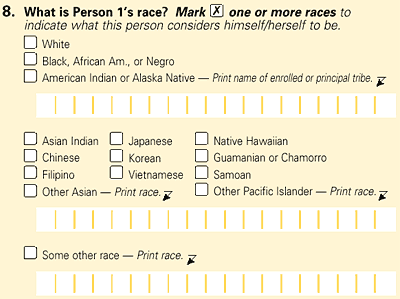Home ![]() Pre Katrina Home
Pre Katrina Home ![]() Articles
Articles ![]() Race & Ethnicity in the Census
Race & Ethnicity in the Census
 Race
& Ethnicity in the Census
Race
& Ethnicity in the Census
Learn how the Census gathers race and ethnicity data and what the Data Center has done to make this data easier for New Orleans nonprofits to work with.
![]()
|
by Allison Plyer |
June 30, 2004| Every ten years the Census asks each of us to report, among other things, the racial and ethnic categories that we consider ourselves to fit in. In recent decades, to accommodate increasing diversity in our country, the category options have become more complex.
The complexity of race and ethnicity categories makes this type of Census data challenging for nonprofit managers to work with. And, the Census race and ethnicity categories are still not a good fit for many U.S. residents.
How does the Census gather race and ethnicity data?
In 2000, the Census considers “ethnicity” different from “race” and asks separate questions for each. The Census’ question about ethnicity asks if we are of Hispanic origin and allows us to indicate the Hispanic group with which we identify.
Here's the ethnicity question as it appeared on the Census form:

|
The new option to check more than one race can cause a slight discrepancy if you compare 2000 to 1990 or older race data. Read more... |
The Census’ question about race presents a set number of race categories, but (for the first time in the year 2000) allows us to select more than one.
Here's the part of the Census form that asks about race:

|
|
Separating race and ethnicity means Census data can be used to examine some of the racial diversity within the Hispanic population, and a bit of the ethnic diversity among the African American and White populations. But the race and ethnicity options the Census offers still do not account for the tremendous diversity that makes up America!
How to use race/ethnicity data in grant proposals
As a nonprofit manager, you may find that the race/ethnicity of the target population you serve informs aspects of your program design. For example, if you plan to offer after-school arts programming in your primarily African American neighborhood, then you will want to consider the cultural relevance of the programming within your community. If you plan to offer literacy training to adults in a neighborhood with a large number of Hispanic residents, you may need bilingual instructors.
To demonstrate the need for the culturally-specific dimensions of your program design, you will want to include race/ethnicity data in your grant proposal. But because of the complexities of the way the Census counts race and ethnicity, this data can be challenging to work with. That’s why we applied a simple calculation to the race and ethnicity data to make it easier to work with.
How does the Data Center present race and ethnicity data?
What we’ve done in each of our “Racial & Ethnic Diversity” tables is combine the Census’ ethnicity data with their race data and at the same time made sure that no numbers were double counted. This is how we did it:
- In our “Hispanic” category, we included the Census’ count of everyone who checked “yes” to the Census’ Hispanic ethnicity question.
- In our other race categories, we included the Census’ counts by race of only those people who checked “no” to the Census’ Hispanic ethnicity question.
With this re-calculation, the numbers of people in the Hispanic population are now directly comparable to those in the Census race categories (such as African American and White).
Most of the racial statistics that you see on the news, especially those that talk about the nation's growing Hispanic population, use this calculation of the Census’ race and ethnicity data. So the Data Center has presented the data in a way that you are probably most familiar with. And hopefully, therefore, we’ve made the very complicated Census race and ethnicity data as easy as possible for you to work with.
Related links:
Short
Form Census 2000, Informational Copy
www.census.gov/dmd/www/pdf/d61a.pdf
(requires
Acrobat
Reader)
To get a better feel for how the race and ethnicity questions were asked
in Census 2000, see the “informational copies” of the Census 2000 short
form.
Using
the New Racial Categories in the 2000 Census
http://www.aecf.org/kidscount/racial2000.pdf
(requires Acrobat
Reader)
For a very
technical description of how to bridge the differences between 1990 and
2000 race categories, read this article published by the Annie E. Casey
Foundation and the Population Reference Bureau.
![]()
Allison Plyer is the Research and Technical Assistance Manager at the Community Data Center.
Home ![]() Pre Katrina Home
Pre Katrina Home ![]() Articles
Articles ![]() Race & Ethnicity in the Census
Race & Ethnicity in the Census
![]()
|
Greater New Orleans Community Data Center
Last modified: December 7, 2006 |